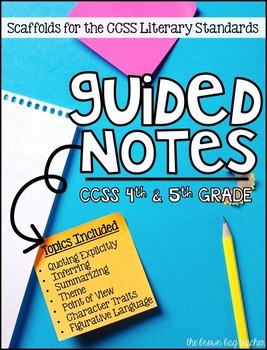5th Grade Guided Notes: Quoting Evidence, Theme, Point of View, Summarizing
Catherine Reed - The Brown Bag Teacher
42k Followers
Grade Levels
4th - 5th
Resource Type
Standards
CCSSRL.5.1
CCSSRL.5.2
CCSSRL.5.3
CCSSRL.5.4
CCSSRL.5.6
Formats Included
- PDF
Pages
18 pages
Catherine Reed - The Brown Bag Teacher
42k Followers
Description
Introduce and teach strategies for quoting explicitly, inferring, summarizing, determining theme, identifying point of view, comparing characters, and identifying types of figurative language. I have included a student and teacher version for each of the 5 text structures, as well as, an introductory set of notes for a text structure overview.
7 Sets of Guided Notes {includes teacher answer key}
*Quoting Explicitly
*Inferring
*Summarizing
*Theme
*Point of View
*Character Traits
*Figurative Language
I used these notes in my 5th grade classroom to introduce and review the CCSS Literature Standards! Guided notes were an accommodation listed on many of my students' Individualized Education Plans. I created these notes to scaffold their learning and act as a fantastic reference for my students throughout the year.
Happy Teaching,
Catherine
The Brown-Bag Teacher
***For other hands-on Common-Core aligned resources, check out my Greek and Latin Root Word Games and my Point of View resource!
7 Sets of Guided Notes {includes teacher answer key}
*Quoting Explicitly
*Inferring
*Summarizing
*Theme
*Point of View
*Character Traits
*Figurative Language
I used these notes in my 5th grade classroom to introduce and review the CCSS Literature Standards! Guided notes were an accommodation listed on many of my students' Individualized Education Plans. I created these notes to scaffold their learning and act as a fantastic reference for my students throughout the year.
Happy Teaching,
Catherine
The Brown-Bag Teacher
***For other hands-on Common-Core aligned resources, check out my Greek and Latin Root Word Games and my Point of View resource!
Total Pages
18 pages
Answer Key
Included
Teaching Duration
1 Semester
Last updated Dec 1st, 2014
Report this resource to TPT
Reported resources will be reviewed by our team. Report this resource to let us know if this resource violates TPT’s content guidelines.
Standards
to see state-specific standards (only available in the US).
CCSSRL.5.1
Quote accurately from a text when explaining what the text says explicitly and when drawing inferences from the text.
CCSSRL.5.2
Determine a theme of a story, drama, or poem from details in the text, including how characters in a story or drama respond to challenges or how the speaker in a poem reflects upon a topic; summarize the text.
CCSSRL.5.3
Compare and contrast two or more characters, settings, or events in a story or drama, drawing on specific details in the text (e.g., how characters interact).
CCSSRL.5.4
Determine the meaning of words and phrases as they are used in a text, including figurative language such as metaphors and similes.
CCSSRL.5.6
Describe how a narrator’s or speaker’s point of view influences how events are described.





